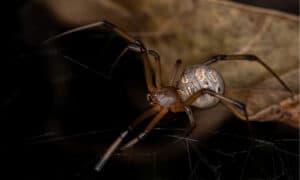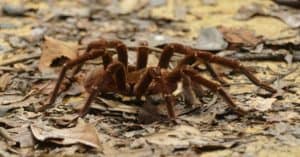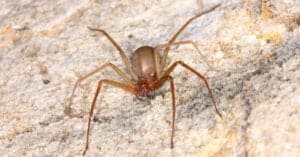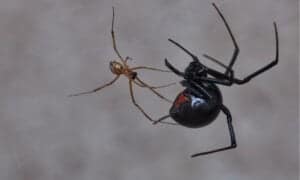Black Widow Spider vs Brown Recluse Spider: 5 Differences
@media (min-width: 481px) {
.mobile-top-content {
display: none;
}
}
#mobileTopContentCTACarouselControls { overflow: hidden; text-overflow: ellipsis; white-space: nowrap; }
.mobile-top-content .more { color: #fff; }
.mobile-top-content a { color: #fff; text-decoration: underline; }
.mobile-top-content a:hover { color: #fff; text-decoration: underline; }
@media (max-width: 480px) {
.mobile-top-content {
background-color: #06a10b;
color: #fff;
text-align: center;
/*height: 60px;
padding-top:5px;*/
font-size:80%;
/* display: block; */
margin: 0px -30px;
}
}
You likely already know what spiders you shouldn’t mess with, but what’s the difference between a black widow spider vs brown recluse spider? Both of these are regarded as some of the most dangerous spider species living on the planet today, but how can you learn to tell them apart so that you can keep yourself safe?
In this article, we will address all of the differences between black widow spiders and brown recluse spiders including their appearance and behaviors. We will also address where they are found in the world and what habitats they typically occupy so that you can make yourself aware. Let’s get started and learn more about spiders now!
Comparing Black Widow Spider vs Brown Recluse Spider

A-Z-Animals.com
| Black Widow Spider | Brown Recluse Spider | |
|---|---|---|
| Size | 1 ½ or 2 inches long | .25-.75 inches long |
| Appearance | Shiny black in color with a red or orange dot on top of its abdomen; females have trademark red hourglass underneath their abdomen | Brown or tan in color with markings where their legs attach to their bodies; has six eyes and fine hairs on legs |
| Location and Habitat | Worldwide. Found in warmer climates and in well-lit areas. Prefer dryness and hides beneath clutter or outdoor materials so long as they aren’t often disturbed | Southern or Midwest United States. Often found in populated areas, in undisturbed areas such as closets or beneath piles of cardboard |
| Behavior | Highly aggressive if guarding eggs or surprised; will bite readily | Reclusive and shy; only bites if surprised or trapped against skin |
| Venom Level | Extremely venomous and likely to bite humans | Venomous and capable of causing tissue death |
Key Differences Between Black Widow Spider vs Brown Recluse Spider
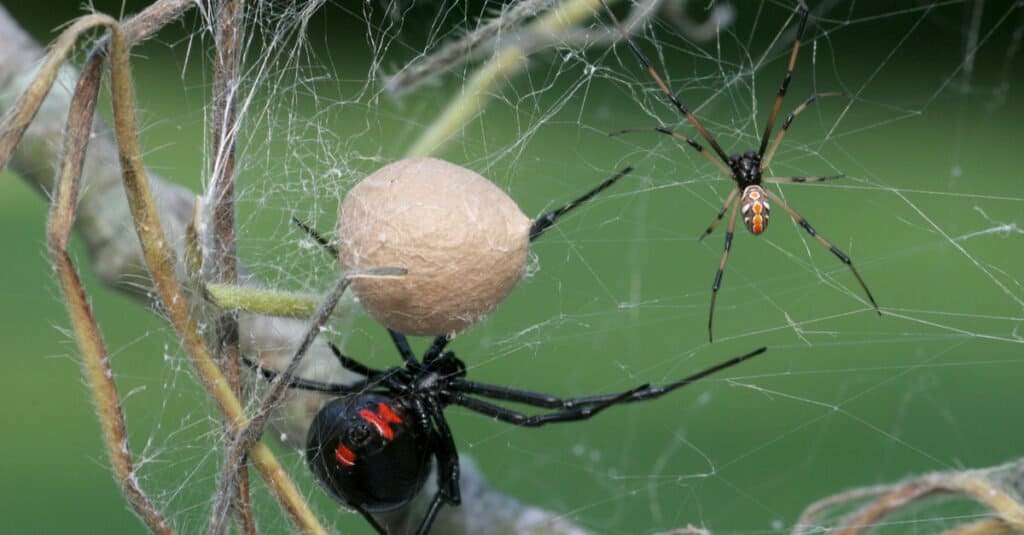
Mark_Kostich/Shutterstock.com
There are many key differences between black widow spiders and brown recluse spiders. The black widow spider grows larger than brown recluse spiders overall. You can find black widow spiders around the world, while brown recluse spiders only live in the southern or Midwestern United States. The appearances of the spiders are very different as well, with black widow spiders having glossy black bodies and brown recluses having brown bodies.
Let’s go over all of these differences in more detail now.
Black Widow Spider vs Brown Recluse Spider: Size

Physics_joe/Shutterstock.com
The average brown recluse spider is much smaller than the average black widow spider. For example, brown recluses grow anywhere from a quarter of an inch to 3/4 of an inch long, while black widow spiders frequently grow anywhere from 1 to 2 inches long. No matter the size, you likely want to avoid either of these spiders if you find one!
Black Widow Spider vs Brown Recluse Spider: Location and Habitat
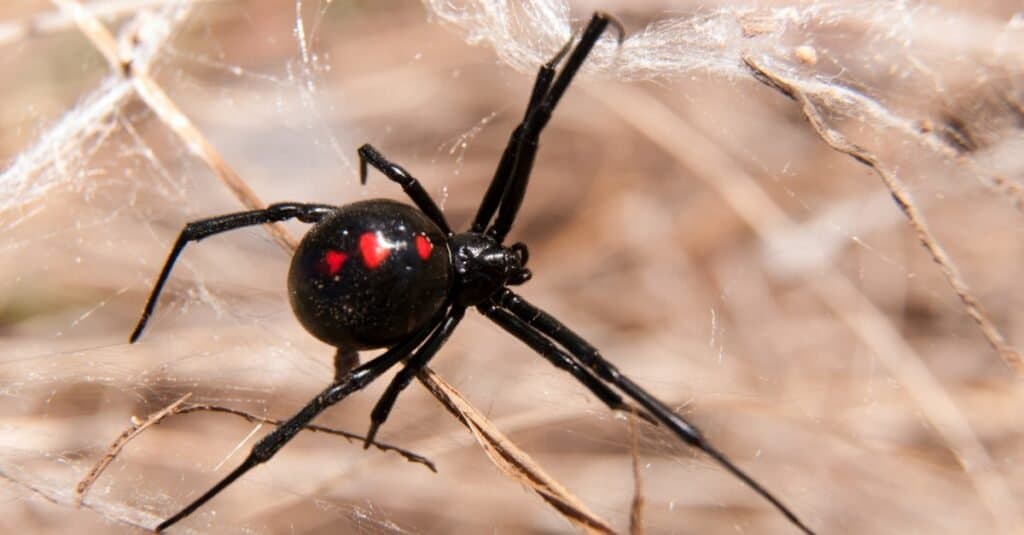
Sari ONeal/Shutterstock.com
One of the most unique things about the brown recluse spider is its limited habitats or locations, while black widow spiders are found around the world. You can only find brown recluses in the southern or Midwestern United States. Black widow spiders are found in the same location and much more.
These two spiders also have different habitat preferences. Black widows enjoy dry climates and hiding under clutter. Brown recluses are found in more humid locations and in populated areas. You will often find a brown recluse in a shed or a closet, or even under piles of cardboard. Black widows prefer outdoor areas such as wood piles.
Black Widow Spider vs Brown Recluse Spider: Appearance
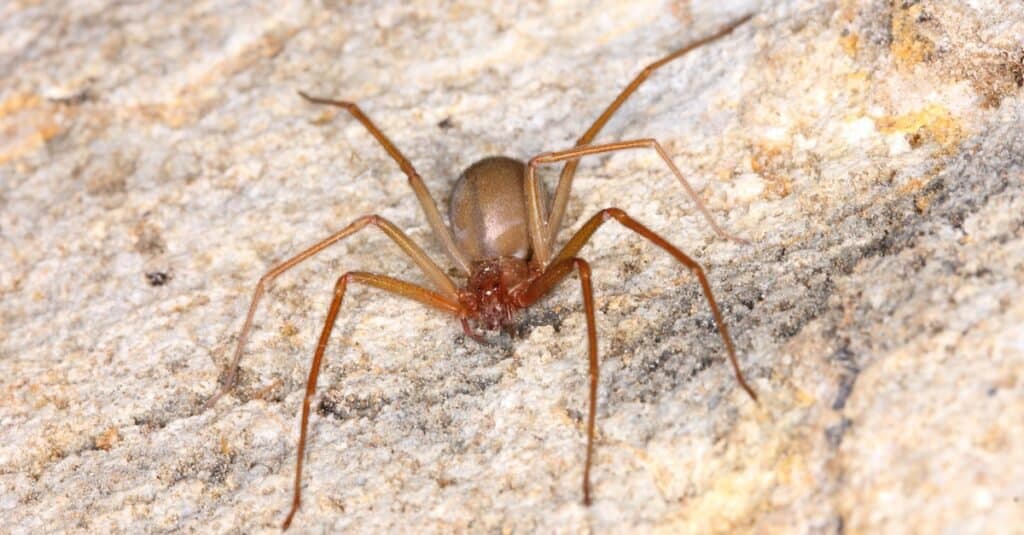
Pong Wira/Shutterstock.com
These two spiders are easy to tell apart once you know what they look like. Black widow spiders have glossy black bodies, while brown recluses have brown or tan bodies. If you get a close enough look, you will notice that brown recluses have six eyes, while black widow spiders have eight eyes. There are even more physical differences- let’s talk about them now.
Female black widow spiders are well known for their red hourglass, found underneath their abdomens, while brown recluses do not have red on their bodies. However, this does not mean that they do not have a distinguishing pattern or marking. Brown recluses have violin shaped markings where their legs meet their abdomens, while black widow spiders only have markings on the top and bottom of their abdomens.
Black Widow Spider vs Brown Recluse Spider: Behavior

Jay Ondreicka/Shutterstock.com
While both of these spiders prefer to be left alone by humans and other animals, there are some behavioral differences between the two. For example, brown recluses live up to their name and prefer to live a reclusive life without confrontation, while black widow spiders can be aggressive if protecting their eggs.
Even though this isn’t a hard-and-fast rule, and both types of spiders will bite if they are surprised, you are more likely to be bitten by a black widow spider and a brown recluse spider. Brown recluses often bite out of fear or accidentally when they are pressed against skin. Black widows lunge more often than brown recluses.
Black Widow Spider vs Brown Recluse Spider: Venom Level
A final difference between black widow spiders and brown recluse spiders has to do with their venom levels and the way in which their venom interacts with the human body. While both of these spiders are very venomous and should be avoided, black widow spider bites cause swelling and fevers, while brown recluse spider bites cause tissue death and decay. No matter what, you won’t have a good time if you are bitten by either of these two spiders!
More from A-Z Animals
.more-snake-card-image { max-height:140px !important; }
@media (min-width: 481px) {
.mobile-top-content {
display: none;
}
}
#mobileTopContentCTACarouselControls { overflow: hidden; text-overflow: ellipsis; white-space: nowrap; }
.mobile-top-content .more { color: #fff; }
.mobile-top-content a { color: #fff; text-decoration: underline; }
.mobile-top-content a:hover { color: #fff; text-decoration: underline; }
@media (max-width: 480px) {
.mobile-top-content {
background-color: #06a10b;
color: #fff;
text-align: center;
/*height: 60px;
padding-top:5px;*/
font-size:80%;
/* display: block; */
margin: 0px -30px;
}
}
You likely already know what spiders you shouldn’t mess with, but what’s the difference between a black widow spider vs brown recluse spider? Both of these are regarded as some of the most dangerous spider species living on the planet today, but how can you learn to tell them apart so that you can keep yourself safe?
In this article, we will address all of the differences between black widow spiders and brown recluse spiders including their appearance and behaviors. We will also address where they are found in the world and what habitats they typically occupy so that you can make yourself aware. Let’s get started and learn more about spiders now!
Comparing Black Widow Spider vs Brown Recluse Spider

A-Z-Animals.com
| Black Widow Spider | Brown Recluse Spider | |
|---|---|---|
| Size | 1 ½ or 2 inches long | .25-.75 inches long |
| Appearance | Shiny black in color with a red or orange dot on top of its abdomen; females have trademark red hourglass underneath their abdomen | Brown or tan in color with markings where their legs attach to their bodies; has six eyes and fine hairs on legs |
| Location and Habitat | Worldwide. Found in warmer climates and in well-lit areas. Prefer dryness and hides beneath clutter or outdoor materials so long as they aren’t often disturbed | Southern or Midwest United States. Often found in populated areas, in undisturbed areas such as closets or beneath piles of cardboard |
| Behavior | Highly aggressive if guarding eggs or surprised; will bite readily | Reclusive and shy; only bites if surprised or trapped against skin |
| Venom Level | Extremely venomous and likely to bite humans | Venomous and capable of causing tissue death |
Key Differences Between Black Widow Spider vs Brown Recluse Spider

Mark_Kostich/Shutterstock.com
There are many key differences between black widow spiders and brown recluse spiders. The black widow spider grows larger than brown recluse spiders overall. You can find black widow spiders around the world, while brown recluse spiders only live in the southern or Midwestern United States. The appearances of the spiders are very different as well, with black widow spiders having glossy black bodies and brown recluses having brown bodies.
Let’s go over all of these differences in more detail now.
Black Widow Spider vs Brown Recluse Spider: Size

Physics_joe/Shutterstock.com
The average brown recluse spider is much smaller than the average black widow spider. For example, brown recluses grow anywhere from a quarter of an inch to 3/4 of an inch long, while black widow spiders frequently grow anywhere from 1 to 2 inches long. No matter the size, you likely want to avoid either of these spiders if you find one!
Black Widow Spider vs Brown Recluse Spider: Location and Habitat

Sari ONeal/Shutterstock.com
One of the most unique things about the brown recluse spider is its limited habitats or locations, while black widow spiders are found around the world. You can only find brown recluses in the southern or Midwestern United States. Black widow spiders are found in the same location and much more.
These two spiders also have different habitat preferences. Black widows enjoy dry climates and hiding under clutter. Brown recluses are found in more humid locations and in populated areas. You will often find a brown recluse in a shed or a closet, or even under piles of cardboard. Black widows prefer outdoor areas such as wood piles.
Black Widow Spider vs Brown Recluse Spider: Appearance

Pong Wira/Shutterstock.com
These two spiders are easy to tell apart once you know what they look like. Black widow spiders have glossy black bodies, while brown recluses have brown or tan bodies. If you get a close enough look, you will notice that brown recluses have six eyes, while black widow spiders have eight eyes. There are even more physical differences- let’s talk about them now.
Female black widow spiders are well known for their red hourglass, found underneath their abdomens, while brown recluses do not have red on their bodies. However, this does not mean that they do not have a distinguishing pattern or marking. Brown recluses have violin shaped markings where their legs meet their abdomens, while black widow spiders only have markings on the top and bottom of their abdomens.
Black Widow Spider vs Brown Recluse Spider: Behavior

Jay Ondreicka/Shutterstock.com
While both of these spiders prefer to be left alone by humans and other animals, there are some behavioral differences between the two. For example, brown recluses live up to their name and prefer to live a reclusive life without confrontation, while black widow spiders can be aggressive if protecting their eggs.
Even though this isn’t a hard-and-fast rule, and both types of spiders will bite if they are surprised, you are more likely to be bitten by a black widow spider and a brown recluse spider. Brown recluses often bite out of fear or accidentally when they are pressed against skin. Black widows lunge more often than brown recluses.
Black Widow Spider vs Brown Recluse Spider: Venom Level
A final difference between black widow spiders and brown recluse spiders has to do with their venom levels and the way in which their venom interacts with the human body. While both of these spiders are very venomous and should be avoided, black widow spider bites cause swelling and fevers, while brown recluse spider bites cause tissue death and decay. No matter what, you won’t have a good time if you are bitten by either of these two spiders!

